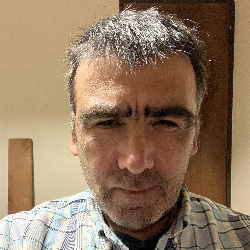


Ignacio E. Olivares is an experimental physicist with a theoretical and mathematical background. He was born in Viña del Mar, Chile in 1961. His father was a chemical engineer and his mother a high school Spanish teacher. Olivares studied at the Institute of Physics, Pontíficia Universidad Católica de Chile (PUC). There, he received a Bachelor's degree in Physics in 1984, and a Master's Degree in Physics in 1987. Afterwards he moved to the Fakultät für Physik und Astronomie, Ruhr Universität Bochum in West Germany and obtained in 1992 his promotion Dr.rer.nat.
In his Bachelor's degree thesis he wrote a pioneering Physical Review article in which he calculated the surface modes of a pair of nanoscopic spheres with different radii. In his Master thesis He constructed from scratch a working Q-switched pulsed ruby laser, including the electronics and the optical cavity. Many of his professors advised him that the decision to switch from theoretical physics to experimental physics was a significant error since it is very hard to do experimental physics in Chile.
In his doctorate in Bochum, he worked in the Experimental Physics V Plasma Spectroscopy Group. His thesis advisor was Professor H. J. Kunze who suggested that he should install a Thomson Scattering experiment in a gas liner pinch using a Q-switch laser. The Thomson Scattering experiment included one of the first available ICCDs for the diagnostics of high-density plasmas. He also worked on plasmas with impurities and combined Thomson Scattering with plasma spectroscopy.
In 1992, he returned to Chile and worked for six months at the Physics Institute of the PUC Plasma Physics Group where he assembled a hollow cathode CW plasma discharge for atomic vapor deposition.
In 1993 he was hired by the Chilean Nuclear Energy Commission where he became leader of the Lithium Laser Isotope Separation Program. There, he built from the ground up a laser spectroscopy facility. He assembled a heat-pipe to study laser absorption in lithium vapors, and resonance ionization spectroscopy. Afterwards, he constructed a laser lithium isotope separation device. These experiments (in the late 1990s) were based on tunable narrow-linewidth diode laser technology. This work led to the world's first isotope separation of lithium using diode lasers.
According to international observers the accomplishment of Olivare's team, on diode laser isotope separation of lithium, has no parallel in Chilean or Latin American experimental physics.
In 2001 he was hired as an Assistant Professor at the Physics Department, Universidad de Santiago de Chile where he installed a laser spectroscopy laboratory. He constructed a magneto optical trap and demonstrated, for the first time in Chile, laser cooling and trapping of atoms. In 2006, he was promoted to Associated Professor.
Olivares has written many articles on laser absorption with rubidium and lithium, laser cooling, Thomson and Mie scattering. Most of this work is included in his book Techniques for Lithium Isotope Separation, Laser cooling, and Scattering, published by the Institute of Physics (UK) in 2022.
In 2017 he was designated Senior Member of Optica. Since this time, he has been teaching optics, theoretical and experimental physics, and created an advanced laser spectroscopy course with tunable diode lasers. Today he continues to work on fundamental aspects of laser development.
Page published on the 15th of September, 2023
Updated on the 15th of September, 2023